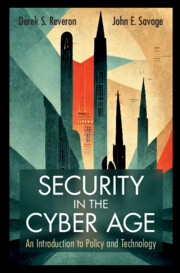Book contents
- Security in the Cyber Age
- Reviews
- Security in the Cyber Age
- Copyright page
- Epigraph
- Contents
- Boxes
- Preface
- Acknowledgments
- Introduction
- 1 The Emergence of Cyberspace and Its Implications
- 2 From the Abacus to the Computer
- 3 Communicating through Cyberspace
- 4 The Human Dimensions of Cyberspace
- 5 Strategy and Cyberspace
- 6 Domestic Regulation of Cyberspace
- 7 Internet Governance and International Institutions
- 8 International Law and Norms in Cyberspace
- 9 Artificial Intelligence and Ethics
- 10 Conclusions and Future Directions of Cybersecurity Policy
- 11 Leading in the Cyber Age
- Glossary
- References
- Index
3 - Communicating through Cyberspace
Published online by Cambridge University Press: 02 November 2023
- Security in the Cyber Age
- Reviews
- Security in the Cyber Age
- Copyright page
- Epigraph
- Contents
- Boxes
- Preface
- Acknowledgments
- Introduction
- 1 The Emergence of Cyberspace and Its Implications
- 2 From the Abacus to the Computer
- 3 Communicating through Cyberspace
- 4 The Human Dimensions of Cyberspace
- 5 Strategy and Cyberspace
- 6 Domestic Regulation of Cyberspace
- 7 Internet Governance and International Institutions
- 8 International Law and Norms in Cyberspace
- 9 Artificial Intelligence and Ethics
- 10 Conclusions and Future Directions of Cybersecurity Policy
- 11 Leading in the Cyber Age
- Glossary
- References
- Index
Summary
Chapter 3 briefly contrasts classic telephone circuit-switched communication with the more flexible packet-switched Internet. It introduces the domain name system(DNS) , which is in effect the telephone directory for the Internet, and describes how domain names are translated into binary addresses. DNS explains basic internet communication protocols, that is, how computers “talk” to one another by sending packets of bits over the Internet and describes the algorithms that route packets along different paths between sources and destinations. Packet routing helps to make packet communication robust in the face of network disruptions, such as might occur during a military conflict. The chapter also details a variety of encryption methods, focusing on public-key cryptography, which is widely used for secure communications that enable shopping online, banking transactions, and privacy. It also introduces digital signatures, the equivalent of a human signature, for authentication of the sender of messages. Finally, it examines threats to secure public-key cryptography.
- Type
- Chapter
- Information
- Security in the Cyber AgeAn Introduction to Policy and Technology, pp. 73 - 107Publisher: Cambridge University PressPrint publication year: 2023



